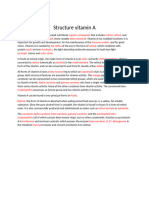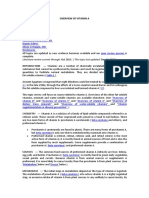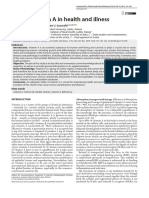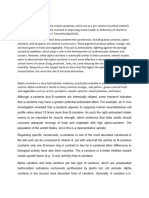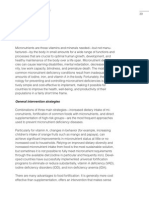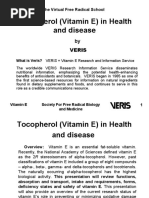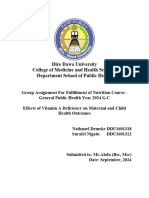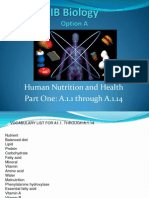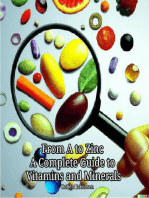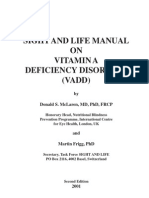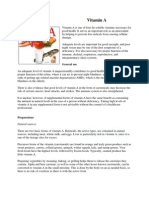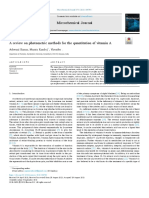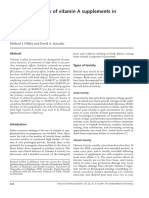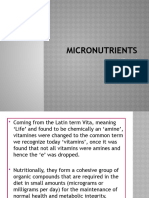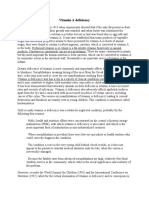Vitamin A
Vitamin A
Uploaded by
huxley2378Copyright:
Available Formats
Vitamin A
Vitamin A
Uploaded by
huxley2378Original Description:
Original Title
Copyright
Available Formats
Share this document
Did you find this document useful?
Is this content inappropriate?
Copyright:
Available Formats
Vitamin A
Vitamin A
Uploaded by
huxley2378Copyright:
Available Formats
SIGHT AND LIFE Guidebook
on Vitamin A
in Health and Disease
by
Donald S. McLaren, MD, PhD, FRCP
and
Martin Frigg, PhD
Second Edition
2001
Contents
Introduction 3
Vitamin A in the world around us 5
Where we get our vitamin A 7
What vitamin A does
and how it works 11
How to test for vitamin A deficiency 15
Eye disease due to
vitamin A deficiency 19
Vitamin A deficiency as a cause
of death and disease 23
Who is vitamin A-deficient and why 27
Vitamin A in general medicine 31
What is being done to control VADD 33
Glossary 37
Task Force SIGHT AND LIFE
PO Box 2116
4002 Basel
Switzerland
Phone: +41 61 688 7494
Fax: +41 61 688 1910
E-mail: sight.life@roche.com
Further information:
http://www.sightandlife.org
ISBN 3-906412-07-5
3
SIGHT AND LIFE
Guidebook on Vitamin A
Introduction
This booklet has been designed for
health workers and other professionals
for whom an understanding of the basic
facts and most recent advances in the
field of vitamin A is of great relevance
in their work. It is not primarily for those
concerned with nutrition, for whom the
SIGHT AND LIFE Manual on Vitamin
A Deficiency Disorders (VADD) may be
more appropriate.
In structure this Guidebook follows
fairly closely the new second edition of
the SIGHT AND LIFE Manual on
Vi tami n A Defi ci ency Di sorders
(VADD). It contains the key messages
from the Manual but gives less em-
phasis to details.
The reader might ask why vitamin A has
been singled out from among all the
various vitamins and the many other
important aspects of nutrition. Com-
ments to this question are given in the
following paragraphs.
Vitamin A deficiency is among the most
common and serious of all nutritional
deficiency diseases and also probably
the one for which there is the greatest
hope of it being brought under control
within the forseeable future.
In recent years startling scientific
discoveries have been made that have
revealed how vitamin A functions as a
hormone at the cellular level in many
systems of the body.
Some years ago it was believed that
disease resulted only from severe
vitamin A deficiency and that it was
confined to being a major cause of
blindness in young children (xeroph-
thalmia). Although xerophthalmia is
much less common than it used to be,
due in part to the many prevention
programmes that have been set up,
many children still go blind every year.
However, over and above this we now
know that deficiency of vitamin A can
lead to a much greater risk of death
and also predispose to suffering from
many infectious diseases. Of great
importance is the fact that these risks
occur when the level of vitamin A
deficiency is what is called subclinical
that is to say there is no clinical
disease and the deficiency can be
revealed only by carrying out bio-
4
SIGHT AND LIFE
Guidebook on Vitamin A
chemical or other laboratory tests. This
subclinical deficiency is very much
more common and widespread than
clinical deficiency like xerophthalmia.
It affects mainly young children and
their mothers during pregnancy and
lactation. This means that the greatest
emphasis now needs to be switched
away from blindness and the eye to the
area of Maternal and Child Health
(MCH). Because many systems are
affected by vitamin A deficiency it
seems appropriate to use a term that
covers all aspects, and vitamin A
deficiency disorders (VADD) is now
being generally accepted for this
purpose.
That having been said, all health
workers need to be aware of what is
going on in the field of vitamin A.
Compared to the common occurrence
of deficiency, excess of vitamin A is very
rare, however, it can also lead to
disease and the danger should be kept
in mind. A careful and controlled use of
supplements is important.
A link is also being made in Section 8
to carotenoids that are closely related
to -carotene and vitamin A. In recent
years they have been shown to have
antioxidant and other functions that
may prove to be important in the
prevention of some common dis-
eases.
It is hoped that some readers will
become fascinated with the unfolding
story of vitamin A and wish to go on
learning about it for them the SIGHT
AND LIFE Manual on Vitamin A De-
ficiency Disorders (VADD) is waiting. It
can be obtained from SIGHT AND LIFE.
5
SIGHT AND LIFE
Guidebook on Vitamin A
Almost wherever we happen to be we
are surrounded by vitamin A in some
form or another. Vi tami n A i tsel f
(retinol), and the closely related acid
form (retinoic acid), which carries out
most of the functions of vitamin A in
the body, are hidden away inside the
bodi es of ani mal s and humans.
However, closely related to vitamin A
are hundreds of compounds be-
longing to the group called carot-
enoi ds. They readi l y attract our
attention as yellow, red and brown
pigments, which are responsible for
the bright colours of many fruits,
vegetables and leaves of trees as
well as the brilliant colours of many
birds, fish and other animals.
Section 1
Vitamin A in the world around us
all-trans -carotene
all-trans retinol
retinyl palmitate
all-trans retinoic acid
11-cis retinal
CHO
COOH
O
CH
2
OCC
15
H
31
CH
2
OH
Figure 1. Chemistry of vitamin A (retinol) and some related compounds
6
SIGHT AND LIFE
Guidebook on Vitamin A
Leafy plants and trees have the ability
to remove carbon dioxide from the
atmosphere and to combine it with
water to form carbohydrates, rich
sources of energy. This process is
known as photosynthesis and requires
light from the sun and the presence in
the leaf of the green pigment chlo-
rophyll, which acts as a catalyst.
Carotenoids also need to be present
to help to harvest the light. In this way
the suns energy is captured and stored
to make all of life possible on earth. The
darker the green colour of leaves the
more chlorophyll they contain and also
the more carotenoid. This is why dark
green leaves are more nutritious than
pale ones. Out of the hundreds of
carotenoids in nature only a small
number are present in our food and
these are of two kinds. One kind, of
which -carotene is the most important,
can be converted in the body to retinol.
Thi s source of vi tami n A from
carotenoids in vegetables and fruits is
the main source for most people in
developing countries, it makes up
7090% of all their dietary vitamin A
intake. Figure 1 shows the formulae
of -carotene, retinol, and some of its
most important related retinoids. The
long chain of -carotene is usually split
in the middle by an enzyme in the
intestine to produce two molecules of
retinol, although in practice much less
than this is available to the body (see
page 8). The other kind of carotenoid,
including lutein and lycopene and
others, cannot form vitamin A but recent
research suggests that they may have
other important functions (see page
32). Laboratory methods are now
available for measuring the amounts of
di fferent forms of reti nol , known
collectively as retinoids, and also
individual carotenoids. HPLC (high-
performance liquid chromotography)
has replaced most other methods but
is expensive and requires high-quality
facilities.
7
SIGHT AND LIFE
Guidebook on Vitamin A
Before we consider the kinds of foods
that provide us with the vitamin A we
require it is necessary to discuss the
units of measurement used for the
expression of vitamin A activity in
foodstuffs and also in body tissues.
Weight for weight -carotene has less
vitamin A activity than preformed
vitamin A (retinol) itself. It has also
been found that other provitamin A
carotenoids, like -carotene, -caro-
tene and cryptoxanthin, have only
about half the activity of -carotene.
Consequentl y the term Reti nol
Equivalent (RE) was coined to make
possible comparison between different
sources of vitamin A activity. It was
decided that retinol is 6 times more
effective than -carotene, which is
twi ce as effecti ve as the other
provitamin A carotenoids. Table 1
indicates these relationships.
In recent years research has cast doubt
on these values as they apply to the
bi oavai l abi l i ty of carotenoi ds to
humans. In general it has been found
that provitamin A carotenoids in dark
green leafy vegetables are much less
readily available than from other
Section 2
Where we get our vitamin A
Table 1. International Units (IU) and Retinol Equivalents (RE)
Compound g/IU IU/g RE/g g/RE
all-trans retinol 0.300 3.33 1.000 1.0
all-trans retinyl acetate 0.344 2.91 0.873 1.15
all-trans retinyl palmitate 0.549 1.82 0.546 1.83
all-trans -carotene 1.800 0.56 0.167 6.0
Mixed carotenoids* 3.600 0.28 0.083 12.0
* Provitamin A carotenoids other than -carotene
8
SIGHT AND LIFE
Guidebook on Vitamin A
sources and that the relationships in
Table 1 overestimate the activity of
carotenoids in the body (Figure 2).
Among the many factors that decrease
the bioavailability of carotenoids the
most important probably are:
the matrix in which the carotenoid
is incorporated in the food,
the presence and amount of
substances that affect absorption,
such as fat, vitamin E, fibre, chlo-
rophyll, and nonprovitamin A
carotenoids,
the nutritional status of the host
and
parasites such as roundworm and
giardia.
It has recently been proposed that the
previous RE values for provitamin A
carotenoids be halved. This would
make -carotene 1/12 as active as
retinol (up to now 1:6), and other
provitamin A carotenoids 1/24 (up to
now 1:12). Some studies have shown
great variability between individuals in
their ability to respond to dosing with
-carotene.
Synthetic
carotenoids in oil
Red palm oil
Yellow or green fruits
Yellow or green tubers
Lightly cooked yellow, orange
or green vegetables or fruit juices
Fresh vegetable juices
Raw yellow or orange vegetables
Raw green leafy vegetables
Figure 2. Hierarchy of carotenoid bioavailability.
9
SIGHT AND LIFE
Guidebook on Vitamin A
Provitamin A carotenoid
sources
Table 2 indicates some common veg-
etable/fruit carotenoid sources and the
approximate amount present.
Leafy vegetables
-carotene is the major source of
vitamin A. Unfortunately, dark green
leaves like spinach, which have high
concentrations of -carotene, are often
regarded as poor mans food or only
fi t for consumpti on by ani mal s.
Moreover, young children constantly
resist having to eat them.
Fruits
The vitamin A activity of fruits is
generally lower than that of leafy
vegetables and their carotenoid content
is more complex. They are much more
readily accepted, especially by young
children, but unless they are processed
they have a short season.
Tomatoes are high in lycopene, a
nonprovitamin A carotenoid that gives
them their dark red colour and may
have some beneficial effects (see
Section 8). Some varieties of tomato
are good sources of -carotene.
Roots and tubers
Carrots are increasingly being grown
in parts of the developing world. The
provitamin A content in carrots, mainly
-carotene and -carotene, varies
consi derabl y between di fferent
species, and raw carrot provides none
at all.
The yellow or orange varieties of roots
and tubers are quite rich sources, while
the more common white varieties
contain almost no carotene. Orange
sweet potato for instance contains 1140
g/100 g fresh weight of -carotene.
Vegetable oils
Most contain little or no carotene, but
red palm oil (see Table 2) is the
richest vegetable source known. Most
is -carotene. The bioavailability is
high. The oil has been refined for
domestic use and the strong natural
flavour, which is not to everyones
taste, has been removed. The fat is
mostly unsaturated. Introduction of
Table 2. Examples of common vegetable/
fruit carotenoid sources
RE/100 g
edible portion
Mango (golden) 307
Papaya (solo) 124
Cucurbita (mature pulp) 862
Buriti palm (pulp) 3,000
Red palm oil 30,000
Carrot 2,000
Dark green leafy vegetables 685
Tomato 100
Apricot 250
Sweet potato, red and yellow 670
10
SIGHT AND LIFE
Guidebook on Vitamin A
red palm oil into parts of the world
where previously it was unknown is
increasing.
Other sources of provitamin A
carotenoids
Hens eggs are rich in carotenoids, but
these are mostly nonprovitamin A.
Natural extracts containing carotenoids
have l ong been used to col our
foodstuffs and make them more
attractive. -carotene is sometimes
used for this purpose and then also
contributes to the nutrient intake.
Sources of preformed
vitamin A
Table 3 shows some common sources.
Fish liver oils are the most concentrated
sources and are often used medicinally.
Dairy products, usually quite ex-
pensive, are only moderate sources.
Table 3. Examples of common animal
vitaminA sources ( g retinol/100 g edible
portion)
Fatty fish liver oils
Halibut 900,000
Cod 18,000
Shark 180,000
Herring and mackerel 50
Dairy produce
Butter 830
Margarine, vitaminized 900
Eggs 140
Milk 40
Cheese, fatty type 320
Meats
Liver of sheep and ox 15,000
Beef, mutton, pork 04
Vitamin A has been added to food for a
long time and fortification is one of the
major long-term approaches to the
control of the problem of VAD (see
page 33).
11
SIGHT AND LIFE
Guidebook on Vitamin A
Vitamin A (retinol) in the body comes
from two sources, preformed vitamin A
in animal foods and from -carotene
and other provitamin A carotenoids in
plant sources. Both of these are
released from protein in the stomach
and like all other lipids are taken up in
the wall of the small intestine and
become part of chylomicrons that enter
the blood circulation. From there they
are taken to the liver, where storage
takes place as retinyl ester mainly in
special cells called stellate cells. For
transport to other parts of the body
retinol is attached to its own protein,
the retinol-binding protein (RBP), and
another protein called transthyretin
(TTR, see Figure 3).
Section 3
What vitamin A does
and how it works
Liver
Retinol
Small intestine
-
Carotene
+ RBP
Parenchymal
cells
Chylomicrons
Other
cells
Epithelia
Stellate cell
(retinyl palmitate)
Eye
(11-cis retinal)
_
_
_
_
_
_
_
_
_
_
_
_
T
T
R
T
T
R
R
B
P
R
Figure 3. Physiology of vitamin A
12
SIGHT AND LIFE
Guidebook on Vitamin A
all over the body it is RA that is the
active form of vitamin A. It has been
shown that many genes are activated
by RAR or RXR nuclear receptors
(Figure 4). These receptors act like
hormones, such as steroids and thyroid
hormones, with which they are closely
linked. It is through this mechanism that
the functions of vitamin A are brought
about, with one exception, vision. In the
rod and cone cel l s of the reti na
responsible for vision the functional
form of vitamin A is not RA but 11-cis
retinal (see page 13).
At the cell membrane retinol is taken
up by receptors (RBP receptors).
Within cells there are cellular retinoid-
binding proteins (CRBPs) that direct
retinoids to specific enzymes and, most
importantly, to the nucleus of the cell.
In recent years it has been discovered
that within the cell nucleus there are
two sets of three nuclear receptors
(known as RARs and RXRs). These
nuclear receptors are activated by an
acidic form of retinol, such as retinoic
acid (RA). In cells of organs and tissues
Extracellular
RBP-ROH
ROH-CRBP
ROH
Receptor
RA
Nucleus
Regulated
gene
transcription
Intracellular
RA-CRABP
RA
RA-RXR RAR-RA
Target cell
D
N
A
ROH = Retinol
RA = Retinoic acid
RBP = Retinol-binding
protein
CRBP = Cellular retinol-
binding protein
CRABP = Cellular retinoic
acid-binding protein
RXR, RAR = Nuclear retinoic
acid receptors
Figure 4. Molecular biology of vitamin A
13
SIGHT AND LIFE
Guidebook on Vitamin A
Functions of vitamin A
Table 4 outlines some of the main
functions of vitamin A in the body.
Vision
The rods cells of the retina contain a
protein, opsin, attached to a form of
vitamin A, 11-cis retinal, to form a
compound that is sensitive to light,
rhodopsi n or vi sual purpl e. On
exposure to light 11-cis retinal is
converted back to all-trans retinal and
a nerve impulse is generated. In VAD
the supply of retinal is reduced and rod
function is impaired.
Cell differentiation
In VAD mucus-secreting cells in many
epithelial tissues are replaced by
kerati n-produci ng cel l s. Thi s i s
G Vision (night, day, colour)
G Epithelial cell integrity against infections
G Immune response
G Haemopoiesis
G Skeletal growth
G Fertility (male and female)
G Embryogenesis
responsi bl e for the xerosi s and
keratinization of the conjunctiva and
cornea and other tissues.
Embryogenesis
Reference is made elsewhere (see
page 32) to the evidence in animals that
both deficiency or excess of vitamin A
can cause congenital malformations.
Humans appear to be more resistant.
Immune response
Healthy epithelial tissues are barriers
to infection, but in VAD these cells are
damaged and invasion by pathogens
becomes easier. Vitamin A appears to
be involved more in cell-mediated
rather than humoral aspects of the
immune response.
Table 4. Functions of vitamin A
14
SIGHT AND LIFE
Guidebook on Vitamin A
Reproduction
Studies in animals show the involve-
ment of vitamin A in spermatogenesis
in the male and the prevention of
placental necrosis and fetal absorption
in the female.
Haemopoiesis
There is a link between iron and vitamin
A in erythropoiesis. Iron deficiency
anaemia responds more completely if
vitamin A is added to iron therapy than
if it is not. The mechanism is not yet
understood.
Growth
Vitamin A is known to be involved in
normal growth of the musculo-skeletal
system. Several field studies have
provided evidence that growth is
impaired in children if severe VAD is
present.
Human requirements for vitamin A
These are usually expressed in terms
of recommended dietary intake (RDI)
values according to age, sex and
physiological state such as pregnancy
and lactation. Table 5 gives some
representative values which tend to be
on the lower side. It will be noted that
the requirements are relatively much
greater in early life. This is mainly be-
cause of the increased needs for
growth, over and above those for
maintenance.
Table 5. Vitamin A requirements
15
SIGHT AND LIFE
Guidebook on Vitamin A
There are varying degrees of VAD as
shown in outline in Table 6. Different
tests are appropriate for detecting
different stages of this process. They
all measure the state of vitamin A
nutri ture i n the body or what i s
usually called vitamin A status. The
measurement of dietary intake of vi-
tamin A over a given period of time,
usually per day, does not measure
status but does give a good general
indication in a population whether or
not there is a serious VAD problem.
Section 4
How to test for vitamin A
deficiency
Subclinical
Increasing
G
reducing stores
deficiency
G
lowering serum level
G
metaplasia
Clinical
G
xerophthalmia
- non-blinding
- blinding
Table 6. Stages of vitamin A deficiency
16
SIGHT AND LIFE
Guidebook on Vitamin A
The eye lesions of VAD
(xerophthalmia)
In the days when attention was focused
on eye disease due to VAD (xeroph-
thalmia) the various stages of damage
to the eye were described and some
of these were chosen to be used in
studies and surveys of the problem.
Using some of these eye signs criteria
were established by WHO for the
diagnosis of a xerophthalmia problem
of public health magnitude (i.e. one that
required prompt action) and these are
shown in Table 7. Characteristics of the
eye lesions of xerophthalmia and their
use in assessment of vitamin A status
are discussed further in Section 5.
Assessment of subclinical
VAD
With one exception these tests are
bi ochemi cal and requi re varyi ng
degrees of sophi sti cated and
expensive laboratory equipment. The
exception is a histological technique
known as conjunctival impression
cytology (CIC). It is based on the fact
that the conjunctiva becomes xerotic
(dry) and keratinized to some extent
before it reaches the stage of X1A,
conjunctival xerosis (see page 19). A
simple light microscope, laboratory
stains and cellulose acetate strips to
obtai n the speci men are al l the
materials that are required. Although
the test showed great promise at first it
has not been found possi bl e to
standardise the results obtained and
even in experienced hands and with
modifications the test has not been
widely adopted.
The biochemical test measuring serum
retinol is the test that has been most
widely used. With techniques like
HPLC accurate estimates can be
obtained. However, the level of retinol
in serum does not truly reflect changes
in vitamin A status because it is in
equilibrium with the stores in the liver
and some other organs.
* Night blindness (XN) > 5% in pregnant
women is a new criterion recently proposed.
Table 7. Criteria for assessing the public
health significance of xerophthalmia and
vitaminA deficiency, based on the preva-
lence among children less than six years
old in the community
Minimum
Criteria prevalence
Clinical (primary)
Night blindness (XN)* 1.0%
Bitots spot (X1B) 0.5%
Corneal xerosis 0. 01%
and/or ulceration/keratomalacia
(X2 + X3A + X3B)
Xerophthalmia-related 0. 05%
corneal scars (XS)
Biochemical (supportive)
Serum retinol (vitaminA) 5. 0%
< 0.35 mol/L (10 g/dL)
17
SIGHT AND LIFE
Guidebook on Vitamin A
Serum retinol does not fall appreciably
until body stores have been virtually
exhausted. Even so, serum retinol
values for large population groups have
been found to be a reliable indication
of their overall vitamin A status and are
especially useful for comparing one
population with another (Table 8). It is
now generally recognized that in the
presence of inflammation, infection or
trauma the acute phase response
causes serum retinol to fall, sometimes
dramatically. During this phase serum
retinol does not reflect vitamin A status.
Serum RBP is easier to measure than
serum retinol and is coming into greater
use. However, it is also lowered in the
acute phase response. Breast milk
retinol has been found useful to assess
the vitamin A status of lactating women
and might be of value for comparing
different groups. It has the advantage
over other biochemical tests of not
requiring blood sampling. The relative
dose response (RDR) and modified
relative dose response (MRDR) tests
assess indirectly the level of liver
vitamin A stores, which under most
conditions are a truer reflection of
vitamin A status than serum retinol.
They are mainly used as research
tests, as is the more recent stable
isotope dilution test.
Table 8. Ranges of prevalence of serum retinol to define a public health problem of
subclinical vitamin A deficiency of varying importance in young children
Prevalence below cut-offs to define a public
health problem and its level of importance
Indicator
(cut-off) Mild Moderate Severe
Serum retinol 2<10% 10<20% 20%
(0.70 mol/l)
19
SIGHT AND LIFE
Guidebook on Vitamin A
The term xerophthalmia is used to in-
clude all signs and symptoms affect-
ing the eye that can be attributed to
vitamin A deficiency. Table 9 lists these
changes and gives their shorthand
symbols. In a general way they are
listed in order of appearance with in-
creasing severity of deficiency.
Night blindness (XN)
As we saw earlier (see page 12) the
rod cells of the retina require vitamin A
to fulfil their function of vision at night.
There are instruments to test rod
functi on but they requi re the
cooperation of the subject and are
unsuitable for use in young children, in
whom VAD is most common. A simple
method is in use in the field to gain an
idea of the vitamin A status of a
community. In areas where VAD is
common there is usually one or more
phrase in the local language for the
inability to see well at night. This
information and some other questions
about a childs night vision form a short
questionnaire (Table 10).
Conjunctival xerosis (X1A)
In extreme cases the dryness,
thi ckeni ng and wri nkl i ng of the
conjunctiva are very obvious. Lesser
degrees are much more common and
in these cases it is very difficult to be
sure that the conjunctiva is abnormal.
Section 5
Eye diseases due to vitamin A
deficiency
Table 9. Xerophthalmia classification by
ocular signs
Night blindness (XN)
Conjunctival xerosis (X1A)
Bitots spot (X1B)
Corneal xerosis (X2)
Corneal ulceration/keratomalacia
<
1
/
3
of corneal surface (X3A)
Corneal ulceration/keratomalacia
1
/
3
of corneal surface (X3B)
Corneal scar (XS)
Xerophthalmic fundus (XF)
20
SIGHT AND LIFE
Guidebook on Vitamin A
Consequentl y i t was deci ded to
exclude this sign from use in field
surveys. Unfortunatel y i t i s sti l l
someti mes bei ng used i n some
surveys and the resul ts are not
reliable.
Bitots spot (X1B)
Figure 5 shows a typical example. The
lesion consists of a local heaping up
of keratinized material on the surface
of the conjunctiva. It is usually present
on the temporal (outer) side of the
conjunctiva and on the area not
normally covered by the lids. It is really
an extreme example of X1A in one
area. Bitots spot is rare in infants, and
the kind that responds to treatment
with vitamin A is most commonly seen
Table 10. Scheme for the classification of
night blindness by interview (WHO, 1996)
1) Does your child have any problem seeing
in the daytime?
2) Does your child have any problem seeing
at nighttime?
3) If (2) = yes, is this problem different from
other children in your community? (Note:
this question is particularly appropriate
where VAD is not very prevalent.)
4) Does your child have night blindness (use
local term that describes the symptom)?
Figure 5. Bitots spot (X1B) on temporal aspect of bulbar conjunctiva in inter-
palpebral fissure. Bubbles of foam are clearly visible.
21
SIGHT AND LIFE
Guidebook on Vitamin A
in older preschool age children. After
that age, in older children and adults
Bitots spots are usually not due to VAD
and these spots should not be used as
an indicator of VAD.
Corneal xerosis (X2)
This is dryness of the cornea just like
that of the conjunctiva. This stage of
haziness on its own is short-lived and
uncommon. Prompt treatment with
vitamin A (see page 34) at this stage
will result in complete cure of the eye
lesion.
Keratomalacia (X3A, X3B)
This is the final stage of xerophthalmia
and results in partial (X3A) or greater
or total (X3B) melting and destruction
of the cornea. Both eyes are usually
affected but not necessarily equally
(Figure 6). Blindness is inevitable and
mortality is high. In any community
keratomalacia is very uncommon and
young children are almost always
those affected.
Figure 6. Colliquative necrosis (keratomalacia) affecting the greater part of the
cornea (X3B).The relative sparing of the superior aspect is typical. Plasma
vitaminA was 4 g/dL in this case.
22
SIGHT AND LIFE
Guidebook on Vitamin A
Figure 7. Bilateral corneal scars (leucomata
XS) in an anaemic and generally malnour-
ished infant. The inferior situation of the scars
is typical.
Corneal scars (XS)
The cornea may be damaged by injury
and many infections as well as by
xerophthalmia. In survivors of ker-
atomalacia scars of varying sizes may
be left on one or both corneas. They
are usually situated in the
lower part of the cornea and
centrally placed; in a six
oclock position (Figure 7). A
diagnosis of XS should not be
made unless the scars relate
to a period of malnutrition in
the past. These i nacti ve
lesions are more common
than active keratomalacia and
can be used in surveys with
care. All the eye signs do not
necessarily appear in the
order gi ven above and
keratomalacia in very young
children may develop rapidly
with no evidence of xerosis.
Xerophthalmic fundus is very
rare and not useful for surveys.
23
SIGHT AND LIFE
Guidebook on Vitamin A
Soon after vitamin A was discovered in
1913 it became known as the anti-
infective vitamin. This was because in
ani mal s and humans vi tami n A,
especially in the form of cod liver oil,
was found to have a beneficial effect
in a number of infectious diseases,
especi al l y respi ratory i nfecti ons,
measles, and puerperal fever (after
childbirth). Some years later effective
drugs against many infections were
i ntroduced and the benefi t from
vitamin A was largely forgotten.
Section 6
Vitamin A deficiency as a cause of
death and disease
-60
-50
-40
-30
-20
-10
0 -
+10
-34
-45
-54
-6
-30
-29
+6
-19
%
C
h
a
n
g
e
Indonesia India Nepal Africa
1990 1988 1988 1990 1991 1991 1992 1992
T. Nadu Aceh Java A. Prad. Sarlahi Jumla Sudan Ghana
Figure 8. Impact of vitamin A on child mortality
24
SIGHT AND LIFE
Guidebook on Vitamin A
The problem of xerophthalmia took
centre stage until in the 1980s large
fi el d tri al s wi th vi tami n A sup-
plementation in young children showed
significant reduction in mortality (see
Figure 8).
More recently one large study has
reported si gni fi cant reducti on i n
maternal mortality with either vitamin
A or -carotene supplementation and
also reduction in postpartum infection.
If these results are confirmed they
might have important implications for
the use of vitamin A in various aspects
of MCH programmes.
The exact mechanism involved is still
not understood but it would seem to be
related to a reduction in the impact of
infectious diseases. Many studies have
investigated the effect of vitamin A
supplementation on various common
infections in children.
The most dramatic benefit has been
obtained in measles with a marked
reduction in mortality of this disease
which is often severe where mal-
nutrition is common. In Africa eye
lesions often occur in measles, and this
is frequently due to a combination of
xerophthalmia, measles itself, which
directly affects the eye, herpes simplex
infection, and damage caused by
traditional eye medicines. Figure 9
illustrates experience of the problem in
one hospital in Africa. The outcome has
been reported to be improved with
vitamin A supplementation in diseases
3.8%
Measles
36.2%
Herpes simplex
26.2%
VAD
13.8%
Traditional medicines
16.2%
Other
3.8%
Unknown
Figure 9. Causes of corneal ulcers in children
25
SIGHT AND LIFE
Guidebook on Vitamin A
like the common causes of infectious
diarrhoea, malaria and meningococcal
disease.
Research results all tend to agree that
the various forms of acute lower res-
piratory tract infection (ALRI), unlike
most infections, do not appear to
respond t o vi t ami n A suppl e-
mentation. The reasons for this are
not underst ood, especi al l y as
experi ment al ani mal s wi t h VAD
usually die with respiratory infections,
but all agree that patients should be
gi ven vi tami n A to i mprove thei r
vitamin A status.
Infants born to women wi th HIV
infection have a higher mortality and
poorer growth, and morbidity and
mortality among these are reduced by
vitamin A supplementation. It was
originally suggested that vitamin A
may reduce the transfer of HIV
i nf ect i on f rom mot hers t o t hei r
offspring but more recently several
trials failed to confirm this.
It has been calculated that improve-
ment of vitamin A status would reduce
the all-cause mortality rate in young
children by about 23% and would be
expected to prevent 1.32.5 million
deaths per year in children aged
under 5 years. Vitamin A supple-
mentation is one of the most effective
and inexpensive of all public health
interventions (see page 33).
27
SIGHT AND LIFE
Guidebook on Vitamin A
Recent calculations show that nearly
250 million preschool children are
subclinically vitamin A deficient this
is almost 50% of those in developing
countries. Three million have xe-
rophthalmia at any one time; about
90% of t hese suff er f rom ni ght
blindness and other non-blinding
xerophthalmia. 10% or 300,000 are
blind with keratomalacia and this
accounts for about 10% of all blind
children in the world. While it is
encouraging to note that the rate of
blindness due to xerophthalmia is
steadily decreasing, only in recent
years has it become evident how
widespread subclinical deficiency is
and what an i mportant cause of
mortality and morbidity it is. The map
(Figure 10) indicates in outline the
vi t ami n A def i ci ency si t uat i on
throughout the world. The majority of
cases occur in south and east Asia,
partly because of the vast populations
and also because most of the poor in
these countries depend heavily on
rice (devoid of carotene). Many are
landless and this means they have to
purchase all their food and have no
means to buy or grow their own
vegetables. Urban slum dwellers are
especially vulnerable, as are those
subsisting in semi-deserts. Rapid
social change, as in some Pacific
islands, and civil strife, wars and
ecologic destruction in much of Africa
and el sewhere often preci pi tate
VADD.
Risk factors for VADD
Age
Preschool age children are most
commonl y affected by VAD and
develop the most severe degrees of
deficiency. This may be due to a
combination of factors such as rapid
growth, adverse effect of infections
and low vitamin A status at birth.
Section 7
Who is vitamin A-deficient
and why
28
SIGHT AND LIFE
Guidebook on Vitamin A
W
H
O
/
N
H
D
P
u
b
l
i
c
h
e
a
l
t
h
i
m
p
o
r
t
a
n
c
e
o
f
v
i
t
a
m
i
n
A
d
e
f
i
c
i
e
n
c
y
p
e
r
c
o
u
n
t
r
y
(
f
r
o
m
i
n
f
o
r
m
a
t
i
o
n
a
v
a
i
l
a
b
l
e
t
o
W
H
O
,
2
0
0
0
)
C
l
i
n
i
c
a
l
d
e
f
i
c
i
e
n
c
y
S
u
b
c
l
i
n
i
c
a
l
d
e
f
i
c
i
e
n
c
y
I
n
s
u
f
f
i
c
i
e
n
t
d
a
t
a
,
b
u
t
p
o
s
s
i
b
i
l
i
t
y
o
f
V
A
D
I
n
s
u
f
f
i
c
i
e
n
t
d
a
t
a
,
b
u
t
V
A
D
u
n
l
i
k
e
l
y
T
h
e
d
e
s
i
g
n
a
t
i
o
n
e
m
p
l
o
y
e
d
a
n
d
t
h
e
p
r
e
s
e
n
t
a
t
i
o
n
o
f
m
a
t
e
r
i
a
l
o
n
t
h
i
s
m
a
p
d
o
n
o
t
i
m
p
l
y
t
h
e
e
x
p
r
e
s
s
i
o
n
o
f
a
n
y
o
p
i
n
i
o
n
w
h
a
t
s
o
e
v
e
r
o
n
t
h
e
p
a
r
t
o
f
t
h
e
W
o
r
l
d
H
e
a
l
t
h
O
r
g
a
n
i
z
a
t
i
o
n
c
o
n
c
e
r
n
i
n
g
t
h
e
l
e
g
a
l
s
t
a
t
u
s
o
f
a
n
y
c
o
u
n
t
r
y
,
t
e
r
r
i
t
o
r
y
,
c
i
t
y
o
r
a
r
e
a
o
r
i
t
s
a
u
t
h
o
r
i
t
i
e
s
,
o
r
c
o
n
c
e
r
n
i
n
g
t
h
e
d
e
l
i
m
i
t
a
t
i
o
n
o
f
i
t
s
f
r
o
n
t
i
e
r
s
o
r
b
o
u
n
d
a
r
i
e
s
.
D
o
t
t
e
d
l
i
n
e
s
r
e
p
r
e
s
e
n
t
a
p
p
r
o
x
i
m
a
t
e
b
o
r
d
e
r
l
i
n
e
s
f
o
r
w
h
i
c
h
t
h
e
r
e
m
a
y
n
o
t
y
e
t
b
e
f
u
l
l
a
g
r
e
e
m
e
n
t
.
W
H
O
0
0
2
9
4
Figure 10. Global occurrence of vitamin A deficiency
29
SIGHT AND LIFE
Guidebook on Vitamin A
Sex
It has been found that for all aspects of
VAD males are more susceptible than
females. The reasons have been much
debated but are not fully understood.
Physiological status
Pregnant and lactating women have
increased requirements for vitamin A
and often develop night blindness or
Bitots spots. School children, perhaps
Figure 11. The VitaminA Deficiency Disorders (VADD) cycle.
30
SIGHT AND LIFE
Guidebook on Vitamin A
because of their adolescent growth
spurt are also vulnerable.
Diet
Factors rel ated to the di et were
discussed previously, e.g. in Section 2.
Season
It is rare to find VAD occurring uniformly
throughout the year. Much more
commonly there is a marked seasonal
pattern, usually together with infections
which tend to precipitate VAD and other
deficiencies in the rainy season. Lack
of availability of vegetables and fruits
in the dry season may also play a part.
Nutritional surveys should take into
account this important factor.
Breast-feeding
There i s much evi dence for the
protective effect of breast-feeding. The
regular supply of preformed vitamin A
and decrease in infections probably
play a part.
Cultural factors
Customs related to the spacing and
limitation of the number of children are
highly protective in a general way.
Infectious diseases
These often precipitate clinical VAD;
the role of individual diseases was
discussed earlier (see Section 6).
Figure 11 indicates how deficiency of
vitamin A may develop and persist in a
community.
31
SIGHT AND LIFE
Guidebook on Vitamin A
While VADD, as described here, are a
problem to some degree in nearly all
developing countries there are a
number of aspects of the use and
misuse of vitamin A that may affect us
all.
Secondary VAD
Secondary, or endogenous, VAD
occurs not because of lack of the
vitamin in the diet but due to one of a
variety of steps in its utilization by the
body that goes wrong. Table 12 shows
how this kind of deficiency may occur.
Fortunately in most cases deficiency
develops rather slowly and does not
often proceed beyond the stage of night
bl i ndness or Bi tots spot, when
treatment can be effective. However, it
usually has to be continued throughout
life unless the underlying disease can
be cured.
Hypervitaminosis A
Vitamin A is stored in the body and if
intake is excessive various systems
can be damaged. Very large doses of
vitamin A, especially in young children,
Section 8
Vitamin A in general medicine
may cause a ri se i n i ntracrani al
pressure that leads to headache,
nausea and vomiting. Withdrawal of the
vitamin results in a rapid return to
normal without harmful long-term
effects. More commonly a higher than
normal intake of vitamin A over a
period of months or even several years
can result in a syndrome that may be
very difficult to diagnose. Common
symptoms are headache, vomiting,
double vision, skin disease, bone and
joint pain and liver damage. Once
di agnosed and vi tami n A i ntake
reduced to normal, symptoms will
gradually subside but damage to the
liver and other organs may not be
reversible.
Pharmacological use of
synthetic retinoids
Large numbers of vitamin A-like
compounds, retinoids, have been
synthesized for use in treatment of
various diseases, especially those
t hat are due t o abnormal di f -
ferentiation of epithelial cells. These
include acne, psoriasis and some
other skin diseases and also some
32
SIGHT AND LIFE
Guidebook on Vitamin A
cancers that affect epithelial tissues
such as breast, skin, colon, and pros-
tate. One form of leukaemia responds
to retinoic acid.
Congenital malformations
Studies in various animal species have
shown that both deficiency or excess
of vitamin A during early fetal life may
result in malformations in various
systems of the body. In contrast to this
in humans there is no firm evidence that
malformations in the fetus are caused
by either lack or excess of vitamin A.
Nevertheless, restrictions are placed
on the amount of vitamin A that can be
safely administered during pregnancy
and lactation (see page 35).
Synthetic retinoids that are being used
to treat a number of skin and other
diseases (see above) are known to be
highly damaging to the fetus if con-
tinued during pregnancy.
Carotenoids and chronic
diseases
This is a very rapidly growing field for
research and can only be touched on
here. It is probably the antioxidant and
other effects of provitamin A and
nonprovitamin A carotenoids in the
body that are responsible for beneficial
results. These have been reported in
such major diseases as coronary heart
disease, some cancers, and the eye
di seases cataract and macul ar
degeneration.
Table 11. Secondary or endogenous
causes of vitaminA deficiency
Diseases Mechanisms
Coeliac disease, Impaired absorption
sprue, obstructive of lipids, including
jaundice, ascariasis, vitaminA
giardiasis, partial or
total gastrectomy
Chronic pancreatitis In some cases
secondary to zinc
deficiency
Chronic liver Storage impaired
disease, especially by damage to
cirrhosis liver cells;
zinc deficiency
enhances the
effect
Severe infection Loss of RBP in urine
Cystic fibrosis Excessive faecal
loss, unrelated
to degree of fat in
stools
Enzyme defect Failure to cleave
-carotene in
small intestine
Heterozygotic One case reported of
reduction of keratomalacia due to
plasma RBP reduced transport
Mutations in the Biochemical but not
gene for RBP clinical deficiency
33
SIGHT AND LIFE
Guidebook on Vitamin A
There are three mai n types of
intervention that are being carried out.
Each has been researched and
practi sed over the past several
decades in many parts of the world.
Each has i ts own parti cul ar
characteristics, its disadvantages and
its advantages. Frequently more than
one intervention is being used at the
same time. In addition, it must be re-
membered that human communities
are not like laboratory animals, capable
of strict control. Many unknown and un-
control l abl e vari abl es exi st. Im-
provement or deterioration of vitamin
A status in these circumstances cannot
be attributed directly or solely to an
intervention.
Dietary modification
The vast majority of the worlds peoples
live in an environment that is capable
of meeti ng al l thei r nutri ti onal
requirements, including that of vitamin
A, without artificial supplementation
of any kind. In the case of vitamin A
knowledge of its sources and the
consequent ordering of family life
should ensure normal vitamin A status.
For example, home or school gardens
can not only meet family vitamin A
requi rements but al so provi de
additional nutrients and income and
help to raise the status of women. Such
programmes are difficult to start and to
sustain. The doubt recently cast on the
bioavailability of provitamin A ca-
rotenoids from dark green leaves and
other sources suggests that some
preformed vitamin A from animal
sources may be needed.
Recently rice has been genetically
modified to contain -carotene. Inten-
sive efforts are under way to make this
golden rice widely available.
Supplementation
Large doses of vitamin A in capsule
or liquid form (200,000 IU) have been
administered prophylactically at 46
months intervals for many years in a
number of countries. Table 12 shows
the WHO-recommended schedule for
Section 9
What is being done to control
VADD
34
SIGHT AND LIFE
Guidebook on Vitamin A
treatment of a patient with signs of
VAD. In a sense this is also a pre-
ventive measure as the last dose is
given with that aim in mind. Table 13
indicates the preventive schedule rec-
ommended by WHO. This should be a
strictly emergency measure as it makes
no contribution towards eradicating the
problem. Although easy to initiate, ex-
perience has shown repeatedly that in
a routine setting coverage falls dramati-
cally to unacceptably low levels. It
should not be considered in isolation,
but thought should be given at the
same time to other long-term mea-
sures. In recent years the national im-
munization days (NIDs) and other
measures as part of the worldwide Ex-
panded Programme of Immunization
(EPI) of WHO has been utilized with
good effect for the distribution of vita-
min A capsules. It is not immune from
the criticisms mentioned above.
Evidence of transiently raised intra-
cranial pressure has occasionally been
noted in vitamin A supplementation
involving infants, but follow-up for 3
years has found no long-term ill effect.
Mention was made (see page 32) of
the possibility of large doses of vita-
min A in early pregnancy causing
mal formati ons i n the devel opi ng
embryo. A number of studies have
provi ded a consensus vi ew that
supplementation of vitamin A not
exceeding 10,000 IU daily is perfectly
safe.
Table 12. Recommended xerophthalmia treatment schedule
oil-miscible oral vitamin A
<1 Year of age 1 Year of age
Immediately 100,000 IU 200,000 IU
Next day 100,000 IU 200,000 lU
24 weeks later 100,000 IU 200,000 IU
Severe Protein-Energy Malnutrition (PEM)
Monthly until PEM resolves 100,000 IU 200,000 IU
35
SIGHT AND LIFE
Guidebook on Vitamin A
Fortification
Addition of a nutrient to a food implies
that a significant proportion of a
population is unable to obtain their daily
requirement from natural food alone.
Recent evidence suggests that this
may wel l be the case i n many
communities in the developing world.
Foodstuffs used i n devel opi ng
countri es whi ch can be forti fi ed
include wheat, rice and other grain
products, tea, dairy foods, margarine,
edible oils, formula foods and speciality
items. Other micronutrients such as
iron and zinc are also being added. For
a successful fortification programme to
be initiated and maintained a great deal
of cooperation is required. Several
studies have shown that in a research
setting it can significantly improve the
vitamin A status of a whole population.
Table 13. Universal vitaminA distribution schedule for preschool children and lactating
mothers
Children 16 years 200,000 IU of vitaminA orally every 36 months.
Infants 611 months 100,000 IU of vitaminA orally every 36 months.
Immunization against measles provides a good
opportunity to give one of these doses (see note).
Lactating mothers 200,000 IU of vitaminA orally once: at delivery
or during the first 8 weeks postpartum if breast-
feeding or during the first 6 weeks if not breast-feeding
to protect the mother and raise breast milk vitamin
A levels to help protect the breast-fed infant.
NOTE: When infants less than six months old are not being breast-fed, supplementation with 50,000 IU
of vitaminA, as single dose or as divided doses of 25,000 IU, should be considered before they reach
the age of six months.
37
SIGHT AND LIFE
Guidebook on Vitamin A
Acute-phase reaction (or response)
(APR) A generalized reaction of the
body to acute infection, inflammation
and injury. Certain proteins, positive
acute-phase proteins, increase in
concentration in plasma. Other pro-
teins, which include retinol-binding
protein (RBP) and transferrin, decrease
in concentration in plasma and are
known as negati ve acute-phase
proteins.
Bioavailability In general the term
refers to the degree to which any
substance in the diet is available after
ingestion for utilization by the body. In
the present context, bioavailability
relates to the degree to which dietary
provitamin A carotenoids are utilized
after ingestion.
Bitots spotHeaping up of keratinized
cel l s on bul bar conj uncti va. An
advanced stage of conjunctival xerosis.
The first description was attributed to
a French physician of that name in the
middle of the 19th century. Not all
Bi tots spots are attri butabl e to
deficiency of vitamin A.
Carotenoids Yellow, orange, or red
pigments occurring in nature. About
600 have been identified, of which less
than 10 have provitamin A activity. They
all have a basic C
40
skeleton which is
made up from successive additions of
C
5
isoprene units.
Chlorophyll A green pigment that
imparts its colour to the leaves of plants
and many vegetables. It is mainly
responsi bl e for the process of
photosynthesi s, whereby i n the
presence of sunlight carbon dioxide
from the atmosphere and water are
converted to carbohydrate, and oxygen
is given off.
Chloroplast This structure in leaves
contains the chlorophyll and carot-
enoids, which act as catalysts in the
process of photosynthesis.
Cis/trans See isomerization.
Conjunctiva The thin layer of tissue
that overlies the white part of the front
of the eye and also lines the inner part
of the lids.
Glossary
38
SIGHT AND LIFE
Guidebook on Vitamin A
Conjunctival impression cytology
(CIC) A technique whereby a cellulose
acetate strip is applied gently to the
surface of the bulbar conjunctiva of the
eye. When the strip is removed the
superficial layer of epithelial cells
adheres to it. The strip with cells is
processed and stained. The his-
tological appearances are studied for
evi dence of earl y kerati ni zati on,
suggestive of subclinical VAD.
Cornea The window in the front part of
the eye through which we see.
Dark adaptation The ability of the rod
cells of the retina of the eye to take over
the function of vision under conditions
of low illumination. This function is
heavily dependent on an adequate
vitamin A status.
Enzyme One of a large number of
proteins whose function is to bring
about a particular chemical reaction in
the body.
Haemopoiesis The process in the
bone marrow by which various kinds
of blood cells are produced.
Hypervitaminosis A Vitamin A status
in which there are an excessive con-
centration of retinol in plasma and
symptoms and signs of toxicity.
Hypovitaminosis A This is syno-
nymous with VAD.
Isomerization A change in the spatial
orientation of a chemical molecule with-
out any change in the basic chemical
structure.
Keratinization A process characteristic
of epithelial tissues. The tissues
undergo a complex series of hardening
and drying changes. Keratinization is
normal in such tissues as skin, but is
abnormal in many other epithelial
tissues, including conjunctiva, cornea,
and epithelial linings of lungs, gut,
urinary tract etc. It is synonymous with
the term xerosis.
Keratomalacia This term is applied to
changes in the cornea in severe VAD.
In addition to keratinization (see above)
of the corneal epithelium there is
softening of the stroma or underlying
tissue.
Meta-analysis A statistical analysis
applied to the data of a group of studies
which all conform to a set of criteria to
ensure similarity as far as possible. The
larger numbers obtained in this way
provide greater statistical power.
Night blindness The subj ecti ve
sensation of difficulty to identify objects
under conditions of low illumination.
Provitamin A Carotenoi ds, l i ke
-carotene, capable of being converted
to vitamin A in the animal body.
39
SIGHT AND LIFE
Guidebook on Vitamin A
Recommended Dietary Allowance or
Intake (RDA, RDI) This relates to the
level of an essential nutrient considered
to be adequate to meet the known
nutritional needs of practically all
healthy persons in a population.
Relative dose response (RDR) A
biochemical test designed to assess
vitamin A status by the indirect estimate
of liver vitamin A stores.
Retinoids A class of compounds
consisting of four isoprenoid units
joined together in a head-to-tail manner
and customari l y contai ni ng fi ve
conjugated double bonds. The term
vi tami n A i s used as a generi c
descriptor for retinoids exhibiting
qualitatively the biological activity of
retinol.
Retinol equivalent (RE) This term was
created to express both preformed
vitamin A and provitamin A carotenoid
equivalents as a single nutritive value.
One RE is equal to 1 g of all-trans
retinol, or to 6 g of all-trans -carotene,
or to 12 g of other provitamin A
carotenoids. It has recently been pro-
posed that the previous RE values for
provitamin A carotenoids be halved.
This would make -carotene 1/12 as
active as retinol (up to now 1:6), and
other provitamin A carotenoids 1/24
(up to now 1:12).
Vitamin The word originally meant
vital amine. Vitamins are vital in the
sense that they are organic com-
pounds that must be included in the
diet in sufficient amount for health.
Their chemical structure varies and
they are not all amines as was first
thought.
Vitamin A As might be expected this
was the first vitamin to be discovered,
in 1913. Chemically it is known as
retinol. It is an alcohol with five carbon-
carbon double bonds and a functional
-ionone ring.
Xerophthalmia A term that applies to
all clinical stages of eye disease
attributable to VAD.
Xerosis See keratinization.
You might also like
- Atlas de Anatomie A Omului McMinnDocument340 pagesAtlas de Anatomie A Omului McMinnoana_4u_89702495% (111)
- Pulmonary RehabilitationDocument412 pagesPulmonary Rehabilitationhuxley237860% (5)
- Pulmonary RehabilitationDocument412 pagesPulmonary Rehabilitationhuxley237860% (5)
- Vitamin A projectDocument6 pagesVitamin A projectjaydeemeh67.6No ratings yet
- SCMS Vol31 No1 Vitamin ADocument6 pagesSCMS Vol31 No1 Vitamin AWill TohallinoNo ratings yet
- Vitamin A: Vitamers Retinol Argentina, Tierra de Amor y VenganzaDocument4 pagesVitamin A: Vitamers Retinol Argentina, Tierra de Amor y VenganzaDanny FentomNo ratings yet
- Vitamin A UptodateDocument11 pagesVitamin A UptodatePrasetya Ismail PermadiNo ratings yet
- Vitamin A and Carotenoid Toxicity: Rune BlomhoffDocument15 pagesVitamin A and Carotenoid Toxicity: Rune BlomhoffDEEVA SKINCARENo ratings yet
- Vitamin A (Retinol) & Beta-Carotene: The Truth AboutDocument20 pagesVitamin A (Retinol) & Beta-Carotene: The Truth AboutArinaNo ratings yet
- Role of VITA Health&IllnessDocument6 pagesRole of VITA Health&IllnessJoyce ParcoNo ratings yet
- Carotenoids /epidemiology of Health Effects 339Document1 pageCarotenoids /epidemiology of Health Effects 339Andreea BalteaNo ratings yet
- Vitamin A: Vitamin A Is A Group of Unsaturated Nutritional OrganicDocument16 pagesVitamin A: Vitamin A Is A Group of Unsaturated Nutritional OrganicMagazin HdPNo ratings yet
- Vitamin ADocument23 pagesVitamin AJenny TaylorNo ratings yet
- Alpha CaroteneDocument25 pagesAlpha CaroteneFrietzy C FernandezNo ratings yet
- VitaminsDocument7 pagesVitaminsbhavadyaNo ratings yet
- Tool2 Chap3Document42 pagesTool2 Chap32begeniusNo ratings yet
- Tocopherol (Vitamin E) in Health and Disease: VerisDocument35 pagesTocopherol (Vitamin E) in Health and Disease: VerisDea SukrisnaNo ratings yet
- Veris TOHDocument35 pagesVeris TOHtofssbiNo ratings yet
- Effects of Vitamin A Deficiency On Maternal and Child Health OutcomesDocument17 pagesEffects of Vitamin A Deficiency On Maternal and Child Health OutcomesREDEEM NNo ratings yet
- Nutritional Biochemistry: Vitamins Dr. Bidhan Chandra KonerDocument50 pagesNutritional Biochemistry: Vitamins Dr. Bidhan Chandra KonerElenanana100% (1)
- Tocopherol (Vitamin E) in Health and Disease: by VerisDocument35 pagesTocopherol (Vitamin E) in Health and Disease: by VerisWill TohallinoNo ratings yet
- Nutrition and The EyeDocument9 pagesNutrition and The Eye2begenius100% (1)
- Vitamin_ADocument2 pagesVitamin_ADessalegn LemmaNo ratings yet
- Vitamin A - How Much Vital and Toxic To The BodyDocument4 pagesVitamin A - How Much Vital and Toxic To The BodyInternational Organization of Scientific Research (IOSR)No ratings yet
- Human Nutrition and Health Part One: A.1.1 Through A.1.14Document16 pagesHuman Nutrition and Health Part One: A.1.1 Through A.1.14Pete Ryan MorganNo ratings yet
- Vitamin A DeficiencyDocument7 pagesVitamin A DeficiencyReham QueNo ratings yet
- Biomarkers Vit ADocument11 pagesBiomarkers Vit AindahlisfiNo ratings yet
- VitaminsDocument18 pagesVitaminsmkingyousif1No ratings yet
- Vitamin A - Health Professional Fact SheetDocument1 pageVitamin A - Health Professional Fact SheetSantiago FlorezNo ratings yet
- Vitamin A v2Document3 pagesVitamin A v2Anne BennettNo ratings yet
- Biochem.Report 1Document13 pagesBiochem.Report 1Huda AzadNo ratings yet
- 5.-VITAMINSDocument49 pages5.-VITAMINSDessalegn LemmaNo ratings yet
- HND-203 (Vitamin ADocument33 pagesHND-203 (Vitamin Asaeedhuda150No ratings yet
- Sight and Life Manual ON Vitamin A Deficiency Disorders (VADD)Document176 pagesSight and Life Manual ON Vitamin A Deficiency Disorders (VADD)amol_taamNo ratings yet
- Dr. Rhonda Patrick - Rebuttal To 'Vitamins Are Bad'Document6 pagesDr. Rhonda Patrick - Rebuttal To 'Vitamins Are Bad'tylerdurdenmademe100% (1)
- Vitamin ADocument14 pagesVitamin ARamadhan OdiestaNo ratings yet
- Food, Nutrition & HyigeineDocument17 pagesFood, Nutrition & HyigeineRishav Raj100% (1)
- Vitamin A: General UseDocument5 pagesVitamin A: General Usecris_itdNo ratings yet
- Ignou CFN 1 Solved Assignment 2018 - 2019Document47 pagesIgnou CFN 1 Solved Assignment 2018 - 2019NEW THINK CLASSES73% (15)
- Dipaolo Anthony Research PenisDocument6 pagesDipaolo Anthony Research Penisanon_758558634No ratings yet
- Thesis On Vitamin A DeficiencyDocument8 pagesThesis On Vitamin A DeficiencyLisa Garcia100% (1)
- Vitamins ThesisDocument6 pagesVitamins Thesisrobinmoralestopeka100% (2)
- 1 s2.0 S0026265X21008778 MainDocument8 pages1 s2.0 S0026265X21008778 MainElena LacramioaraNo ratings yet
- Safety and Toxicity of Vitamin A Supplements in PregnancyDocument19 pagesSafety and Toxicity of Vitamin A Supplements in Pregnancyms01421789No ratings yet
- C. Nutrition & Ocular SenescenceDocument8 pagesC. Nutrition & Ocular SenescenceKwenzie FortalezaNo ratings yet
- Micronutrients, VitaminsDocument32 pagesMicronutrients, VitaminsEsdras DountioNo ratings yet
- Understanding Vitamin A Deficiency: Insights, Interventions, and InnovationsFrom EverandUnderstanding Vitamin A Deficiency: Insights, Interventions, and InnovationsNo ratings yet
- 6 Thiamin (Vitamin B)Document8 pages6 Thiamin (Vitamin B)Vincent Fang Soon KeongNo ratings yet
- Chapter 17 - Nutritional Agents - 2008 - Clinical Ocular PharmacologyDocument7 pagesChapter 17 - Nutritional Agents - 2008 - Clinical Ocular PharmacologysNo ratings yet
- Vitamin A EnglishDocument5 pagesVitamin A EnglishFika RisvitaNo ratings yet
- VitaminsDocument15 pagesVitaminsRajeswari Ranganathan100% (2)
- J Cnur 2020 10 003Document13 pagesJ Cnur 2020 10 003Nicolas AdrianoNo ratings yet
- Squire Ellis FinalDocument24 pagesSquire Ellis FinalRico714No ratings yet
- 01 Chapter 1Document9 pages01 Chapter 1yssifzakiatuNo ratings yet
- TC Fry LifeScience LESSON 9 - VitaminsDocument30 pagesTC Fry LifeScience LESSON 9 - VitaminsManish KhanchandaniNo ratings yet
- Animal Nutrition, 7th EditionDocument855 pagesAnimal Nutrition, 7th EditionFilon Ioan AlexandruNo ratings yet
- Vitamin EDocument11 pagesVitamin EcloogisNo ratings yet
- Vitamin ADocument23 pagesVitamin AAmin AksherNo ratings yet
- Vitamins and Vitamins Containing DrugsDocument26 pagesVitamins and Vitamins Containing DrugshadassahNo ratings yet
- VITAMINSDocument18 pagesVITAMINSAyesha AfzalNo ratings yet
- Vitamin A DeficiencyDocument10 pagesVitamin A DeficiencyMd. Muhaiminul IslamNo ratings yet
- 4 - Therapeutic Effects of Low Frequency Currents On TissuesIVDocument52 pages4 - Therapeutic Effects of Low Frequency Currents On TissuesIVhuxley2378No ratings yet
- Clinical Application of ElectrotherapyDocument46 pagesClinical Application of Electrotherapyhuxley2378100% (3)


